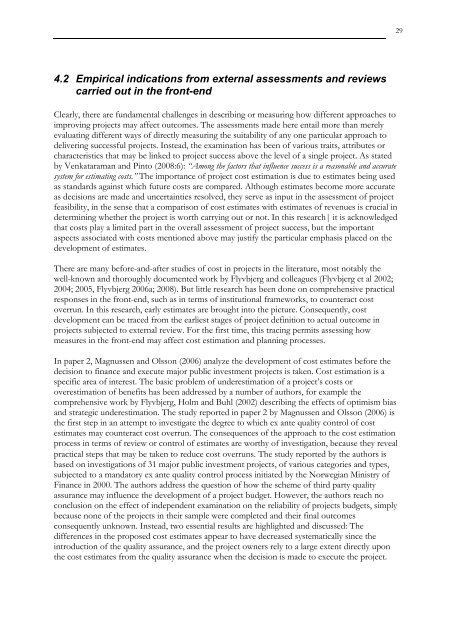Link to thesis. - Concept - NTNU
Link to thesis. - Concept - NTNU
Link to thesis. - Concept - NTNU
- No tags were found...
Create successful ePaper yourself
Turn your PDF publications into a flip-book with our unique Google optimized e-Paper software.
294.2 Empirical indications from external assessments and reviewscarried out in the front-endClearly, there are fundamental challenges in describing or measuring how different approaches <strong>to</strong>improving projects may affect outcomes. The assessments made here entail more than merelyevaluating different ways of directly measuring the suitability of any one particular approach <strong>to</strong>delivering successful projects. Instead, the examination has been of various traits, attributes orcharacteristics that may be linked <strong>to</strong> project success above the level of a single project. As statedby Venkataraman and Pin<strong>to</strong> (2008:6): “Among the fac<strong>to</strong>rs that influence success is a reasonable and accuratesystem for estimating costs.” The importance of project cost estimation is due <strong>to</strong> estimates being usedas standards against which future costs are compared. Although estimates become more accurateas decisions are made and uncertainties resolved, they serve as input in the assessment of projectfeasibility, in the sense that a comparison of cost estimates with estimates of revenues is crucial indetermining whether the project is worth carrying out or not. In this research| it is acknowledgedthat costs play a limited part in the overall assessment of project success, but the importantaspects associated with costs mentioned above may justify the particular emphasis placed on thedevelopment of estimates.There are many before-and-after studies of cost in projects in the literature, most notably thewell-known and thoroughly documented work by Flyvbjerg and colleagues (Flyvbjerg et al 2002;2004; 2005, Flyvbjerg 2006a; 2008). But little research has been done on comprehensive practicalresponses in the front-end, such as in terms of institutional frameworks, <strong>to</strong> counteract cos<strong>to</strong>verrun. In this research, early estimates are brought in<strong>to</strong> the picture. Consequently, costdevelopment can be traced from the earliest stages of project definition <strong>to</strong> actual outcome inprojects subjected <strong>to</strong> external review. For the first time, this tracing permits assessing howmeasures in the front-end may affect cost estimation and planning processes.In paper 2, Magnussen and Olsson (2006) analyze the development of cost estimates before thedecision <strong>to</strong> finance and execute major public investment projects is taken. Cost estimation is aspecific area of interest. The basic problem of underestimation of a project’s costs oroverestimation of benefits has been addressed by a number of authors, for example thecomprehensive work by Flyvbjerg, Holm and Buhl (2002) describing the effects of optimism biasand strategic underestimation. The study reported in paper 2 by Magnussen and Olsson (2006) isthe first step in an attempt <strong>to</strong> investigate the degree <strong>to</strong> which ex ante quality control of costestimates may counteract cost overrun. The consequences of the approach <strong>to</strong> the cost estimationprocess in terms of review or control of estimates are worthy of investigation, because they revealpractical steps that may be taken <strong>to</strong> reduce cost overruns. The study reported by the authors isbased on investigations of 31 major public investment projects, of various categories and types,subjected <strong>to</strong> a manda<strong>to</strong>ry ex ante quality control process initiated by the Norwegian Ministry ofFinance in 2000. The authors address the question of how the scheme of third party qualityassurance may influence the development of a project budget. However, the authors reach noconclusion on the effect of independent examination on the reliability of projects budgets, simplybecause none of the projects in their sample were completed and their final outcomesconsequently unknown. Instead, two essential results are highlighted and discussed: Thedifferences in the proposed cost estimates appear <strong>to</strong> have decreased systematically since theintroduction of the quality assurance, and the project owners rely <strong>to</strong> a large extent directly uponthe cost estimates from the quality assurance when the decision is made <strong>to</strong> execute the project.
















